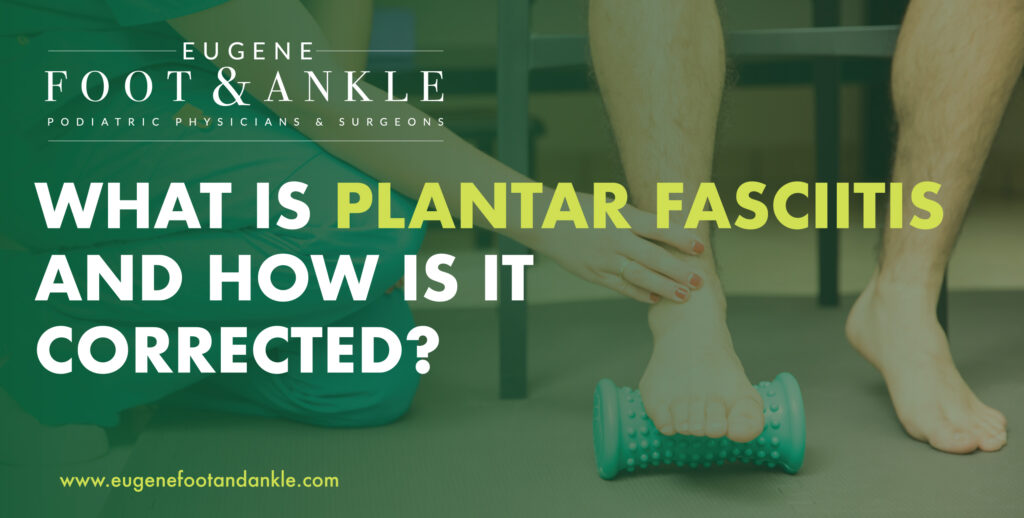What is Plantar Fasciitis and How is it Corrected?
As a leading cause of heel pain, plantar fasciitis, also known as plantar heel pain, affects 1 in 10 people according to the Centers for Disease Control (CDC). Stabbing pain in the heel is the most reported symptom. However, pain may also be felt along the bottom of the foot. The pain may range from mild to severe. Fortunately, most patients respond well to nonsurgical treatments, once they have received a diagnosis. Here’s what you need to know about the most common cause of heel pain.

Plantar Fasciitis: An Overview
The tissue that runs along the bottom of your foot, is by design, thick and sturdy. After all, it is responsible for connecting your heel bone to the base of your toes. Called the plantar fascia, this band absorbs shock to the feet and body, stemming from running, walking, jumping, etc.
Stress, strain, and tension on the plantar fascia result in small tears that lead to irritation and inflammation. The pain that develops in the heel is due to this irritation and inflammation.
Podiatrists have developed risk factors that may make some people more likely to develop this type of heel pain. But the condition can affect anyone. However, those most at risk tend to be:
- Runners, dancers, athletes
- People between the age of 40-60
- People who spend extended periods standing on hard surfaces
- Patients who are overweight
- People with flat feet
- People with high arches in the feet
- Pregnant people
Treatments for Plantar Fasciitis
The bad news for patients dealing with an inflamed or irritated plantar fascia is that it can take some time for the inflammation or irritation to be resolved. The good news is that the condition responds very well to lifestyle modifications and non-surgical therapies. Once your doctor has diagnosed the condition, treatment options include:
- Medical grade over-the-counter or custom orthotics
- Physical therapy
- Non-steroidal anti-inflammatory medications (NSAIDs)
- Walking boot
- Night splints
- Steroid injections
- Ultrasonic tissue repair
- Extracorporeal shock wave therapy

In addition to treatments that your podiatrist provides, they may also suggest that you make some of the following lifestyle changes to reduce the pain, and promote healing. Examples of lifestyle modifications and at-home therapies include:
- Switching to supportive shoes (good arch support, plenty of cushioning, and thick soles)
- Losing weight if overweight
- Replacing high-impact exercises with gentler exercises (swimming instead of running, etc.)
- At-home exercises as demonstrated by your podiatrist
- Icing the bottom of the foot
Surgery is only considered if all non-surgical treatments have failed. Surgery for plantar fasciitis is rare but may be necessary to release a tight plantar fascia. If surgery is required, it can often be performed on an outpatient basis by a Board-Certified foot surgeon.
What is Causing Your Heel Pain? Book an Appointment in Eugene
Heel pain can be caused by conditions other than plantar fasciitis, so an accurate diagnosis is essential. Other conditions that may cause heel pain include inflammation of the Achilles tendon (Achilles Tendinitis a heel spur (bony growth on the bottom of the heel bone), bursitis, rheumatoid arthritis, and bone bruises. To schedule an appointment for heel pain in Eugene, contact Eugene Foot & Ankle at 541-683-3351, or send us a message today.
Contact Us
Eugene
Hours:
Monday............ 8:00am - 5:00pm
Tuesday............ 8:00am - 5:00pm
Wednesday............ 8:00am - 5:00pm
Thursday............ 8:00am - 5:00pm
Friday............ 8:00am - 4:00pm (Only available on phones)
Closed for lunch from 12pm - 1pm and closed until 1:30pm on Tuesdays
© Copyright 2025 Eugene Foot and Ankle. All Rights Reserved. | Privacy Policy.
